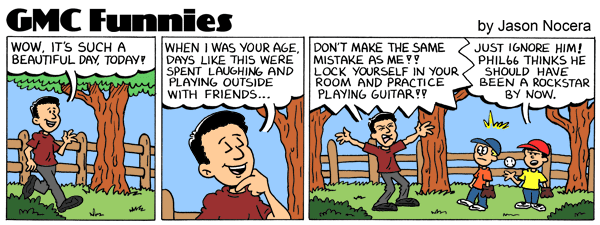Generally, when learning a scale we focus on a box position. We'll repeat it up and down, invariably hitting the wrong notes and adjusting our finger a fret at a time until we've memorised the pattern. Until the next day where we find ourselves having to
repeat the process again and again. Generally, during these stages, we end up learning a pattern but when we try to apply the scale or move it elsewhere along the neck we suddenly can't figure out where we are at all. I think a big part of this is because when we start learning a new scale we
forget to actually absorb the sound of it. It's not your fault or mine. We're always presented with scale diagrams so that's what we use to figure out the new mode. But one thing I've found the most helpful is learning the sound of a scale, not just concentrating on the finger positions. So, how do we do that?
Back in my early days I started trying to figure out the minor scale. I don't remember if it was a conscious decision or what. I don't know why I chose E minor either but for some reason I focused on that scale and I used the top E string to do it with. It could be my memory playing tricks with me because our memory does condense time into brief, poignant moments enabling us to forget how long things took or how hard they were but, bearing that in mind, it really didn't take that long. In no time I had the sound fully in my head. I could distinguish between that and the major scale quite comfortably, even if I couldn't play through the major scale as easily. The key was distinguishing the difference between the sounds in my head.
The mind is always the starting point for whatever we do. If we have something to start from like sound recognition, then it's only a case of giving our hands time to put it into practise.
So, how did I do it? I combined the audio recognition of the scale with the finger positions of my fingers. Starting on the root note, I'd move down (or up) and figure out the physical distance between that note and the next and store it according to the sound I was hearing. Association. After a while of doing that I knew that I'd have to move a whole tone or semitone from whatever position to get the correct interval. After long enough of doing that, you can hear intervals and see their position in your head before you need to play them. This comes in handy during phrasing, even in another scale position. You just get used to knowing the difference between a whole tone, semitone or whole tone and a half. Eventually you can start figuring out the distance of 5ths and so on.
But it all starts with distinguishing the aural difference between tones and semitones and then associating them with needing to place your finger 1 fret away or two frets away.
Another way I've used to learn more exotic modes is by hitting them from different sides. WTF? Let's pretend we're learning a new mode in A. Use the open A string as your start point. First learn the first 3 intervals up to the 3rd. Then find the octave of A at the 12th fret. Does the mode have a dominant 7th or a major 7th? Use this moment to move down from the octave of A to find your 7th, then your 6th.
Also, find the 5th. From the 5th, move either way. Move from the 5th down to the 4th and 3rd, back down to the root. Then try it the other way, moving back up to the octave at the 12th fret.
Essentially the idea is that you use one string to get to know the key chord tones like the 3rd, 5th and 7th. If you can find them using such reference points as the open string and the octave then you can start to link them up. Also, using just one string makes your realise that it really doesn't take that long to get through the intervals. It can seem a lot less confusing and intimidating than running the scale over multiple strings.
All of this, hopefully, can help you to start hearing the scale and then when you fully hear the scale you can start to see the scale. Seeing notes before you need them is an essential skill to improvisation. Sure, some of what we do relies on already learned licks but there will always be times where we need to reach strong target notes on the fly and that will require us to know the difference between moving up a whole tone or skipping that next scale interval and moving up 2 whole tone.
I've bombarded you with a lot of info and no pictures or sound clips, which can be difficult to take in. But even if you don't understand everything I've written, just try to approach your next scale learning session with the mind of learning how it sounds.
Also, please share with us how you have learned scales. Are there any particular methods that work for you?
You are at GuitarMasterClass.net
Don't miss today's
free lick. Plus all our lessons are packed with
free content!























